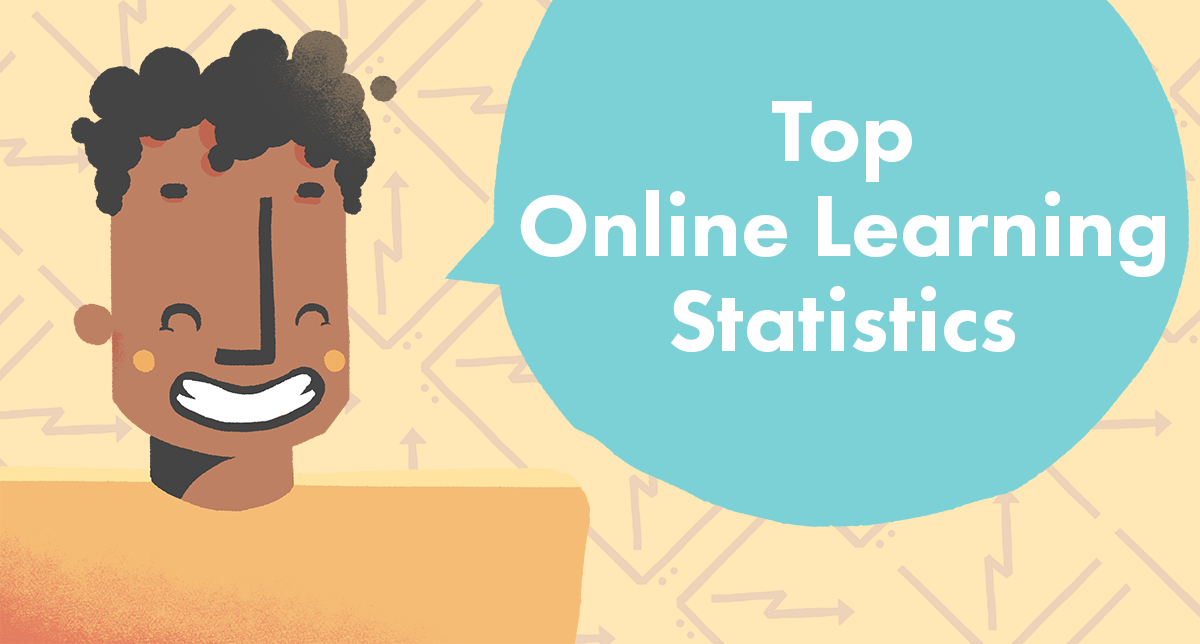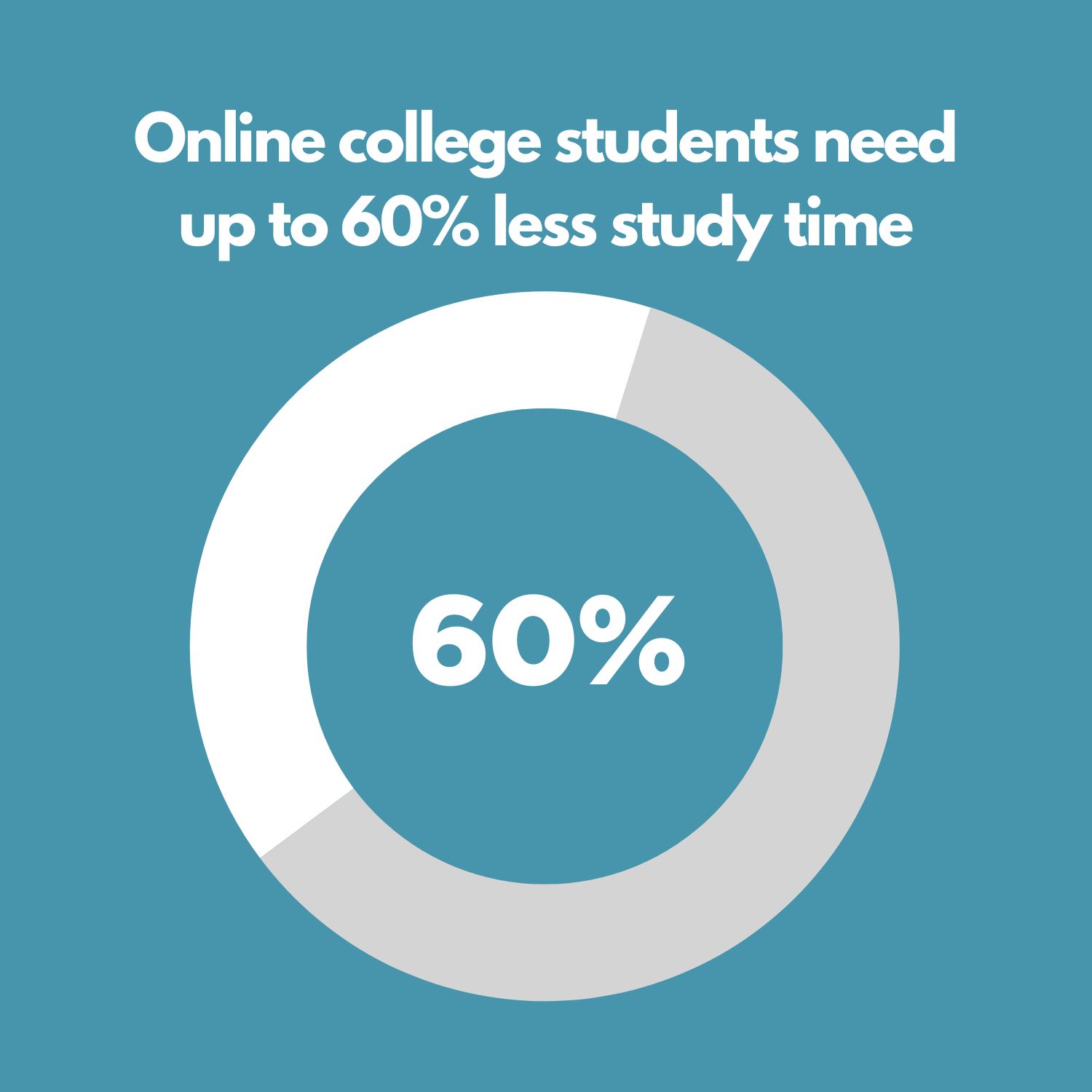

What are the top online learning statistics?
Online learning has exploded in popularity. It can be done anywhere, at any time, and, most importantly, is just as effective as in-person learning.
Want to learn more? We’ve put together a list of the best statistics.
Let’s dive in!
Also referred to as eLearning or distance learning, online learning is remote learning via the internet. Higher education, K-12, and adult learning facilities all use online learning to some extent.
And these statistics reveal what the online learning industry looks like today, as well as what it's predicted to look like in the years to come.
There’s a lot to cover. Let’s start with the best online education growth statistics.
(Oxford College)
Since its launch in 2000, the worldwide market for online learning has grown by more than 900%. It is the fastest-growing market in the education industry.
That’s unsurprising, given that there’s a course for everyone, from those interested in getting a degree to someone who wants to learn as a hobby.
(Syngene Research)
Estimates show that between 2018 and 2026, the online learning industry will grow by as much as 9.1% each year.
(Global Industry Analysts Inc.)
The online learning industry continues to grow rapidly with no signs of slowing down.
In 2022, the US market was worth $100 billion, which makes it the largest in the world. Research estimates that at this rate, it will grow to $686.9 billion by the year 2030.
China is home to the second-largest online learning industry in the world. By 2030, it is projected to reach $171 billion.
(Guru99)
There’s no question that online learning grew exponentially thanks to the Covid-19 pandemic. Just five years after the outbreak, it’s expected that the industry will have grown by more than 200%.
(Email Vendor Selection)
That’s up from $165 billion in 2014, marking a nearly $100 billion increase in less than a decade. It’s safe to say it’s not going anywhere.
(Prosperityforall)
According to estimates, the number of people who take an online course will rise to as many as 57 million people by 2027.
(Statista)
Worldwide, the US’ online learning market will generate more revenue than any other in 2023, with an estimated total of $74.800 million.
(Taylor & Francis Online)
Studies show that more than one-third of American students have enrolled in one or more online courses. Of those students, more than half also participated in on-campus courses as well.
(Statista)
Women are more likely to enroll in online courses, though just barely.
Of undergraduate students who studied online in 2020, 50% were female and 49% were male. Of graduate students in the same time period, 52% were female and 48% were male.
(National Center for Education Statistics)
In the fall of 2019, just 2.4 million students were pursuing their education exclusively online.
When the Covid-19 pandemic began, that number jumped by nearly 200% to a total of 7 million students.
(National Center for Education Statistics)
The number of students who took one or more online courses – but didn’t study online exclusively – increased by 97% between 2019 and 2020.
(The Report)
Referred to MOOCs for short, these courses have been available since 2011 and have seen record numbers of students signing up each year.
In 2022, 220 million subscribed to at least one. That’s a noticeable increase from the 40 million who signed up in 2021.
(Bay Atlantic University)
More than two in five online learners said they committed to a program because it fit in with their current responsibilities, both in their personal and professional lives. That’s no surprise – most courses can be done anywhere, any time, making it an easy addition to their lives.
(Bay Atlantic University)
However, there’s more to choosing to study online than just learning at your own pace.
In the same study, 30% of respondents said they chose to get an online degree to increase their chances of landing a better-paying job.
Money was the main driver for most. When asked, just 23% said they embarked on their online learning journey to get a job more aligned with their interests.
(99Guru)
It’s never too late to learn something new – almost half of all students studying online are at least 30 years of age!
(Open University)
According to research done in the United Kingdom, online learning isn’t just better for students – it’s also better for the environment than traditional classroom learning!
Because students and faculty no longer have to travel for lessons, each student produces 85% fewer carbon dioxide emissions, thus reducing their carbon footprint.
And because online classes don’t take place in campus facilities, energy consumption is also reduced by nearly 90%.
(Guru99)
There’s plenty to mention when we share the benefits of online learning statistics, and increased retention is at the top of the list.
Studies suggest that students retain 25% to 60% of what they learn, which is a stark increase from the 8% to 10% retention rate seen in traditional learning.
(Guru99)
In-person vs. online learning statistics show that online learning is just as effective than in-person learning (if not more).
In addition to improving retention rate, online learning also reduces study time by 40% to 60% for students and employees alike.
(TechJury)
You might still be asking, what is the success rate of online learning? It’s high.
That’s because higher retention rates and less study time pay off: When asked, 81% of students said that digital technology and online learning helped them improve their grades.
(Bay Atlantic University)
While online education is known to improve several skills, 85% of students say critical thinking and problem-solving are the areas they see the most change in.
(Bay Atlantic University)
Online learning does more than just improve retention. Three out of five said that it helped them improve soft skills such as teamwork, communication, and time management as well.
(Statista)
Research has found that of American graduate students, two in five believe that online education actually offers a better all-around experience than a traditional experience in a college-level classroom.
(BestColleges)
An overwhelming majority of online program alumni say that they would recommend pursuing online education.
(University of the Potomac)
When asked, 70% of students said that they feel that online classes are a better alternative to the traditional classroom setting.
(Technavio)
While much of the market is dedicated to education, more than half of its share comes from the type of content learning you might find on Skillshare or Udemy. In content learning, classes could be on anything from speaking French to learning to cook.
(Oxford College)
In a United Kingdom study, almost 2 in 5 students said that studying for and completing an online course is easier than doing so in a traditional classroom setting – but 29% disagreed, saying that it’s just as difficult.
(ThinkImpact)
Online learning isn’t just for students anymore. Today, as many as 77% of companies provide a selection of online learning or training for employees and new team members.

(PapersOwl)
When done correctly, online learning in a corporate environment can help increase employee engagement by as much as 18%.
(American Heart Association)
Allowing an employee to learn at their own pace increases their retention by 25-67% while also improving performance by as much as 25%.
(TechJury)
Studies have found that across US organizations, 42% have seen an increase in income with the implementation of online learning. Within those companies, profit margins increase by an average of 24% as well.
(TechJury)
As if a 24% profit margin increase wasn’t impressive enough, revenue per employee increased dramatically after the introduction of online learning as well, by an average of 218%.
(SHIFT)
IBM’s eLearning program allowed its employees to absorb almost five times the amount of material than they were prior without having to spend any additional time in training, ultimately reducing training costs.
(Brandon Hall)
Because it can be performed asynchronously, online learning takes 40% to 60% less time for employees to learn the same material than the time it takes in a classroom setting.
(CertifyMe)
Of corporations who offer it, 72% say that online learning increases their competitive edge in their market, as it helps them better keep up with and adapt to industry changes.
(Upskillwise)
There’s no question that the pandemic fueled these trends – the statistics of online learning during Covid-19 prove it – but even in a post-pandemic world, it’s here to stay. Today, 98% of universities offer online courses.
(Statista)
With a projected market volume of $103.8 billion in 2023, university-based education has the largest market share of the online learning industry.
(Oxford College)
Because of its market share, it’s no surprise that in the UK, nearly one-third of students would consider getting their university degree online.
Business courses are the most popular type of elearning
(Bay Atlantic University)
Of those who have completed an online course, 30% chose business, making it the most popular. Computers and IT are second-most popular (19%), followed by health and medicine (14%).
(McKinsey)
Traditional university enrollment has dropped by an average of 3%, but online universities are surging – enrollment at the largest universities is up by an average of 11%.
(Guru99)
The K-12 online learning statistics we’re seeing prove it’s here to stay, with 63% using online learning tools at least once per day.
(ThinkImpact)
Just as it does in the corporate world, online learning saves time for college students. On average, they reduce their learning time by 40%-60%.

(ThinkImpact)
During the Covid-19 pandemic, three out of four schools across America changed to operating completely online.
(Guru99)
With so many schools pivoting to online-only, students everywhere are having to adapt. Already, a majority of K-12 students (72%) are using cloud-based tools.
(Bay Atlantic University)
When the pandemic hit, almost half of full-time faculty members received training in online learning. Interestingly, just 36% of part-time faculty members had.
(ThinkImpact)
About one in five public schools were teaching online prior to the pandemic. Even fewer private schools did so, at just 13%.
(National Center for Education Statistics)
75% of undergraduates take at least one online course during their time, compared to 71% of graduate students.
(National Center for Education Statistics)
More than 3 in 4 public college students take at least one online course during their education. They’re more likely to do so than their private college counterparts, just 68% of whom will.
(National Center for Education Statistics)
76% of students at four-year institutions will take an online course, compared to 69% of students at two-year institutions.
(Lumina Foundation)
Despite often being known as an affordable education alternative, studies show that remote learners pay higher tuition than their in-person counterparts.
(College Navigator)
While less than the average yearly tuition at a traditional institution, online colleges are still expensive, at an average of $15,467 per year.
(College Navigator)
When considering a 30-credit hour year, online education averages out to $516 per credit hour. However, the least expensive options can cost as little as $200 per credit hour.
(College Navigator)
On average, getting a degree from a public online college will cost about $10,000 per year.
(College Navigator)
Private non-profit online colleges are more expensive than their public counterparts at $15,000 per year. That’s still less than private for-profit options, which cost $17,000 per year on average.
(Statista)
We’ve touched on how online college education is the largest sector of the market, and the numbers agree: in 2023, the average revenue per user will reach $21,000.
(MarketScale)
In America, low antivirus compliance rates open the door to school-wide shutdowns that last weeks.
Patch ages average 183 days for Microsoft Windows 10 and 31 days for Apple MacOS devices, leaving plenty of time for ransomware attacks to happen in schools across the country.
(MarketScale)
With the internet at their fingertips, it’s no surprise that online students spend an average of one hour per day viewing inappropriate sites. It’s a tricky problem to navigate, as web filtering solutions fail when school devices are disconnected. In fact, 41% of schools see rogue VPNs.
(ACT Research)
The digital divide is a very real threat, especially in online education.
In the US, 25% of low-income students have limited access to the technology and internet needed to study successfully. In comparison, only 18% of students who weren’t first-generation or low-income had the same issues.
There you have it. Those are the top online learning statistics this year.
Ultimately, online learning is growing fast – and these statistics prove it.
Read more
What is eLearning? eLearning Explained
How to Become an Instructional Designer
Sources
National Center for Education Statistics
National Center for Education Statistics
